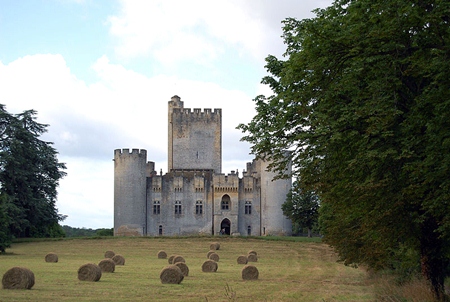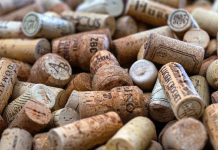Think Bordeaux; think wine. It’s been made in the region since the eighth century. Bordeaux city lies on the banks of the Garonne River and the oldest part of the city is on the UNESCO World Heritage List as an outstanding example of eighteenth century architecture and design. Bordeaux wine comes from anywhere among the 400 square miles of surrounding vineyards where there are more than 8,500 producers.
The boundaries of Graves begin at the outskirts of Bordeaux and stretch over 30 miles to the south on the left bank of the Garonne River. The name Graves (GRAHV) is derived from the French “gravelly land” because the glaciers of the Ice Age left white quartz deposits that can still be found in the soil of some of the vineyards. Graves, where the vine has grown over two thousand years, is considered to be the birthplace of Bordeaux wine.
 Château de Roquetaillade, Graves (Photo: Pline)
Château de Roquetaillade, Graves (Photo: Pline)
For the visitor, there are plenty of Gallo-Roman remains to explore in this attractive landscape of gentle slopes, steep valleys and endless vines. It’s also good walking country. Graves is the only region in Bordeaux where they make red wine, white wine and sweet wine. But the reds predominate. As you might expect, Cabernet Sauvignon is the most important grape, but compared to most other regions of Bordeaux, local winemakers tend to blend in a higher proportion of other grapes, notably Merlot, Cabernet Franc, Petit Verdot and Malbec. This makes the reds of Graves smoother and fruitier than many other wines of Bordeaux.
Château Tour des Graves (red), France (Bt. 610 @ Tesco-Lotus)
This is a pleasant-looking dark red with a gentle and inviting floral aroma. You’ll probably notice the smells of black fruit and a touch of oak. The taste comes as a delightful surprise, because it’s very soft and seductive on the palate, caused by the high proportion of Merlot in the blend. There’s plenty of black fruit and black cherries on the taste and a very soft layer of ripe tannin that continues right through the long finish.
Wines from the Medoc further north tend to be rather serious in character, but this charming wine has a delightful touch of lightness. You might also pick up a very slightly earthy quality on the taste, which is typical of Graves wines and a lot more attractive than it might sound.
“L’Esprit de Bacchus” Graves 2011 (red) France (Bt. 665 @ Foodland)
You may have come across the L’Esprit de Bacchus brand before, because the company produces a range of good table wines. In case you’d forgotten (or possibly never knew), Bacchus was the Roman name for Dionysus, the ancient Greek god of the grape harvest, winemaking and wine. The label of this wine carries the text Appellation Graves Contrôlée, which puts it a cut above the more basic Appellation Bordeaux Contrôlée. It actually comes from Château Saint Loubert, an estate of about 34 hectares (that’s just over eighty acres) and one of the oldest châteaux in the region. The vineyard has typical sandy, gravelly soil and the wine is made by traditional methods.
Now you might wonder what you get for the extra fifty baht. In this case, you’ll get a better wine and in some ways, an exceptional one with rather more character and finesse than the Ch. Tour des Graves. It’s a rich, deep red with that inviting slightly oily look. Long legs appear inside the glass when you swirl it around and you’ll recognise a typical Cabernet Sauvignon aroma of black fruit, cherries, a dash of spice and dried herbs. You might even pick up a hint of dark chocolate.
The wine is a blend of 50% Cabernet Sauvignon and 50% Merlot and has a lovely, smooth, silky texture. It’s medium-bodied and as dry as they come, but the plentiful soft fruit balances the dryness. There’s a good foundation of supple tannin which persists beautifully through the long finish. At just 13% alcohol content, it would make a good partner for red meats, many Asian dishes and fairly strong cheeses. This wine even has ageing potential and you could probably keep it for up to five years, if you have the somewhere cool enough.
Amazingly, Bordeaux is one of the very few regions in France without a famous local cheese. As far as I know, it might be the only one.




